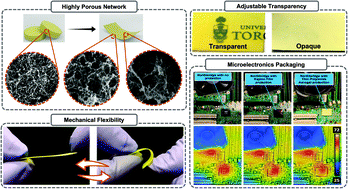Novel, flexible, and transparent thin film polyimide aerogels with enhanced thermal insulation and high service temperature†
Abstract
Due to their high service temperature, excellent thermal insulation, nanoporous morphology, and low dielectric constant, polyimide (PI) aerogels have the potential capability to be used in the next generation of microelectronic devices and flexible electronics. The main challenge, however, is controlling the shrinkage during the sol–gel process, and developing thin films with improved thermal insulation, reduced shrinkage and density, and controllable thickness while maintaining mechanical flexibility. Yet, the majority of previously reported PI aerogels were in the form of bulk monolithic, with a very limited number of studies on other configurations. In this study, thin film PI aerogels are developed via a doctor blade applicator. Through control of processing parameters, namely solution viscosity, casting speed and inter-blade spacing, thin film PI aerogels with controllable thickness and uniformity are fabricated. The PI aerogel network is formed through imidization of flexible 4,4′-oxydianiline (ODA) and biphenyl-tetracarboxylic acid dianhydride (BPDA) monomers. Replacing 50 mol% of the ODA with a more rigid 2,2′-dimethylbenzidine (DMBZ) in the oligomer backbone gives aerogels with improved strength, enhanced hydrophobicity and lower dielectric constant. 1,3,5-Benzenetricarbonyl trichloride (BTC) is used to create a cross-linked network with strong integrity. Compared to previously used cross-linkers (TAB, OAPS, or TAPP), BTC has a lower cost and is commercially available. Several characterization techniques were performed to examine the physical, chemical, thermal, mechanical, electrical, and optical properties of the fabricated aerogels. These highlighted the multifunctionality of the PI aerogels, combining outstanding mechanical flexibility (fully bendable and rollable), excellent strength (compression E = ∼1.9 MPa), ultralow thermal conductivity (27.5 mW m−1), lightweight (ρ = 0.089 g cm−3), superior service temperature (over 560 °C), ultralow dielectric constant (∼2.7), and excellent self-extinguishing behavior. As a potential application of the fabricated thin film PI aerogels, microelectronics packaging can be thus proposed.

- This article is part of the themed collection: 2022 Journal of Materials Chemistry C Most Popular Articles


 Please wait while we load your content...
Please wait while we load your content...